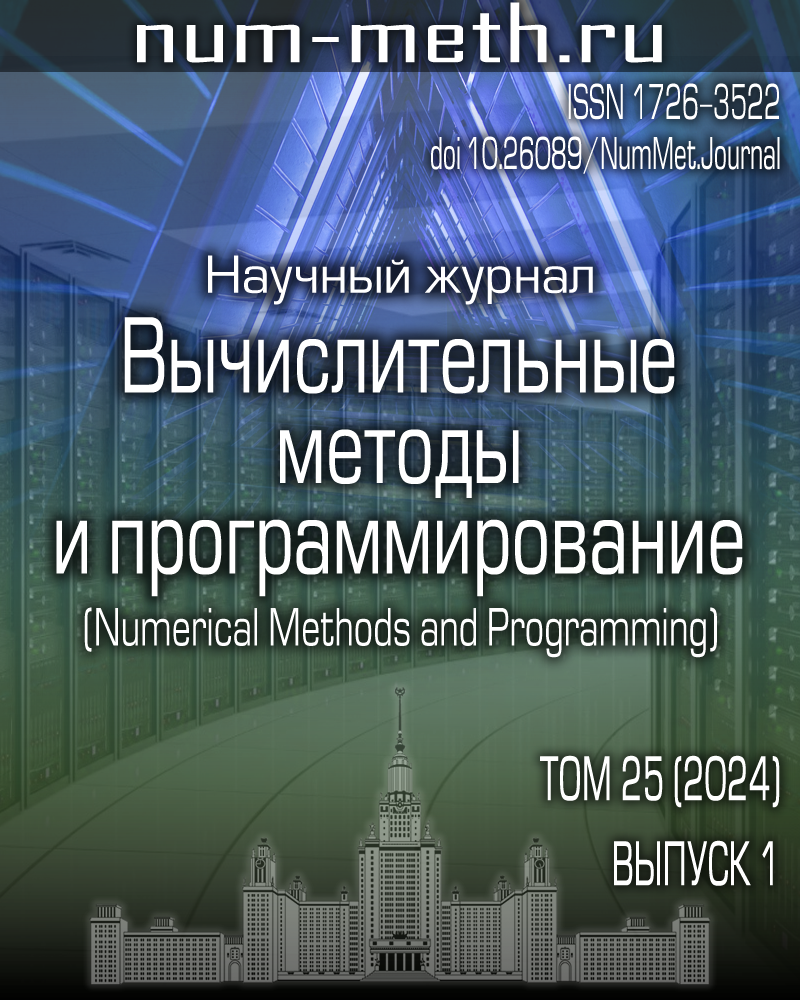|
|
Numerical methods and programming, 2018, Volume 19, Issue 1, Pages 96–111
(Mi vmp902)
|
 |
|
 |
This article is cited in 1 scientific paper (total in 1 paper)
Solving boundary value problems for partial differential equations in triangular domains by the least squares collocation method
V. P. Shapeev, V. A. Belyaev
Khristianovich Institute of Theoretical and Applied Mechanics, Siberian Branch of the Russian Academy of Sciences, Novosibirsk
Abstract:
A high-accuracy new version of the least squares collocation method (LSC) is proposed and implemented for the numerical solution of boundary value problems for PDEs in triangular domains. The implementation of this approach and numerical experiments are performed using the examples of the biharmonic and Poisson equations. The solution of the biharmonic equation with high accuracy is used to simulate the stress-strain state of an isotropic triangular plate under the action of a transverse load. The differential problems are projected onto the space of fourth-degree polynomials by the LSC method. The boundary conditions for the approximate solution are given exactly on the boundary of the computational domain, which allows us theoretically and indefinitely to increase the order of accuracy of the LSC. The new version of the LSC utilizes a regular grid with rectangular cells inside the domain of the solution. It is relatively easy to use a “single” layer of irregular cells that are cut off by the boundary from the rectangular cells of the initial regular grid. Triangular irregular boundary cells are joint to the adjacent quadrangular or pentagonal cells. Thus, a separate piece of the analytical solution is constructed in combined cells. The collocation and matching points situated outside the domain are used to approximate the differential equations in the boundary cells crossed by the boundary. These two methods allows us to reduce significantly the condition number of the system of linear algebraic equations in the approximate compared to the case when the triangular cells are used as independent ones for constructing an approximate solution of the problem and when the extraboundary part of the boundary cells is not used. The advantage of the proposed approach is shown in comparison with the approach using the mapping of the triangular domain onto the rectangular one. It is also shown that the approximate solution converges with a high order and is coincident with the analytical solution of the test problems with a high accuracy.
Keywords:
least squares collocation method, boundary value problem, triangular domain, higher order approximation, Poisson's equation, biharmonic equation.
Received: 25.01.2018
Citation:
V. P. Shapeev, V. A. Belyaev, “Solving boundary value problems for partial differential equations in triangular domains by the least squares collocation method”, Num. Meth. Prog., 19:1 (2018), 96–111
Linking options:
https://www.mathnet.ru/eng/vmp902 https://www.mathnet.ru/eng/vmp/v19/i1/p96
|

| Statistics & downloads: |
| Abstract page: | 284 | | Full-text PDF : | 137 |
|




 Contact us:
Contact us: Terms of Use
Terms of Use
 Registration to the website
Registration to the website Logotypes
Logotypes








 Citation in format
Citation in format 
